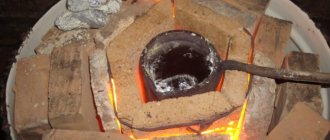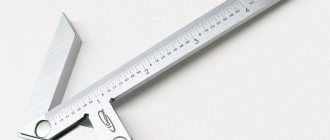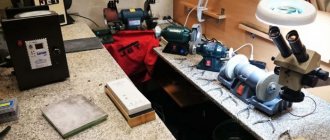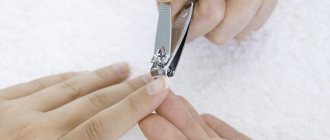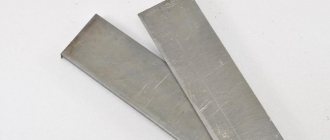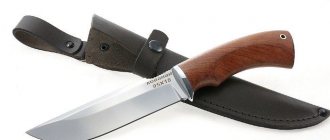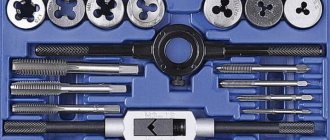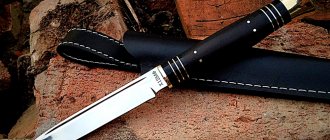Modern housewives use non-stick cookware in their kitchens, made of stainless steel, high-strength plastic, and baking containers made of heat-resistant glass. But brass cookware is the oldest kitchen utensil, standing out for its polished finish, golden luster, aesthetic appearance and useful properties.
Many people still have Soviet cup holders from the USSR era, made of brass. The question is whether it is possible to use such candy dishes, jugs, coffee grinders, plates, samovars today, and whether they are as safe as previously thought.
Tree
In Rus', dishes were originally made of wood. They ate with wooden spoons from wooden bowls, and used wooden bowls, ladles and jugs. In addition, they wove containers from birch bark - salt shakers, containers for storing flour and cereals.
It is known that birch bark has many medicinal properties - from bactericidal to tonic. This is how the body of our ancestors gradually accumulated the healing properties of trees.
But it is important to take into account that wooden utensils painted with Khokhloma should not be used as food.
Copper
Copper utensils appeared next. Perhaps you also have a copper basin or saucepan in your kitchen? Indeed, in many families, dishes made of copper and its alloys are passed down from generation to generation. And no wonder: they always used it with pleasure! The fact is that, due to its high thermal conductivity, copper has a remarkable quality for cooking - heat is evenly distributed over the surface of the cookware. And therefore, delicious jam, aromatic coffee or a wonderful sauce are obtained in a copper container as if by themselves.
But modern science somewhat dims our emotions - from its point of view, even a very small amount of this metal destroys ascorbic acid in berries and fruits.
And one more thing: food stored in a copper container loses vitamins, polyunsaturated fatty acids in it are easily oxidized, forming compounds dangerous to the body - free radicals. With its frequent use, poisoning is possible.
In addition, copper in a humid environment easily oxidizes and a green or blue-green film appears on the dishes - patina. When heated, it interacts with food acids, forming copper salts that are harmful to the body.
Therefore, after washing, the plate or basin must be thoroughly wiped, avoiding the formation of a film. If patina does appear, then before using the dishes it must be carefully removed from the entire surface. You can do this this way: wipe with table salt soaked in vinegar, and immediately rinse first with warm, then with cold water.
If you have copper utensils, we recommend that you read more about proper handling of them, unless, of course, you value your health. This is not the purpose of this article.
Copper cookware: pros and cons. How to care. Photos, tips, ideas
For a long time in Rus' there were only bowls and plates carved from wood. Many years later, copper utensils appeared and existed in our kitchens for many years. Copper products have always been in demand, and even modern housewives often cook jam exclusively in copper basins.
Dishes made from this metal look elegant. It is believed that food prepared in such vessels has a special taste. Food cooks faster due to uniform heat distribution on the surface. However, copper also has negative qualities.
Copper in the kitchen
Items made from this material are attractive with their appearance: they will look elegant in any kitchen and create a beautiful “highlight” of the decor. The following items are made from copper raw materials:
- frying pans;
- pots of any size;
- coffee pots, teapots, Turks;
- fondue makers.
Manufacturers sometimes combine copper and other materials to make handles or lids, which can extend the life of the product.
Professional chefs use metal utensils all the time. Its value lies in reducing the cooking time. Copper is characterized by high heat conductivity, which allows the products to be used to create even particularly complex culinary delights.
The benefits of dishes
Unlike aluminum, copper conducts heat twice as well. “Stainless steel” is significantly inferior to it in these qualities: its heat conductivity is ten times lower.
That’s why in many restaurants they cook on copper utensils, because everything cooks quickly and well in them, without burning. Pans made of this metal are also suitable for everyday use.
It is a good idea to purchase a copper kettle, which will boil water faster.
The main beneficial property of copper products is their antibacterial effect. This substance fights fungi and bacteria, preventing them from penetrating food. In ancient times, metal utensils made of copper were used to disinfect liquids.
Researchers from the USA conducted experiments and proved that this metal copes well with E. coli and salmonella, that is, food cooked in a frying pan or pan is cleared of microbes, which prevents the occurrence of stomach or intestinal diseases.
Negative qualities
In addition to the positive properties, copper metal utensils have several disadvantages. Scientists have identified several negative qualities that can harm health.
- The presence of acids in vegetables and fruits. Under the influence of copper, the beneficial vitamin is destroyed.
- You cannot store fruit, vegetable and berry products in metal containers, as fatty acids will oxidize, which can cause cancer.
- The greatest harm is possible when storing dishes in an environment with high humidity. It will cause a green coating to appear on the surface, which indicates oxidation.
- Plaque occurs when food acids are heated; in addition, when exposed to heat, acids produce substances that are very harmful to humans. If plaque appears on the walls of the dishes, remove it by wiping it with salt soaked in vinegar.
- The high price and special care make daily use of copper-based cookware inconvenient. On store shelves, metal utensils shine, and when people buy a saucepan, they discover a protective film on the outside that must be washed off before the first cooking. After that, it will have to be cleaned every time after its use.
Containers made of this material are contraindicated for preparing food intended for small children or people with alcohol addiction. In infants, this substance can cause liver disease. When drinking alcohol, this chemical element enters the body and is absorbed in large quantities, which can lead to cirrhosis of the liver.
Inner coating
Any metal utensils have a main flaw - oxidation. This reaction occurs due to contact with acidic foods. To avoid this feature of copper, the inside of the container, be it a saucepan or a copper kettle, is coated with a layer of alloy. Steel is durable, but damage to tin can be repaired.
Tin-based coating is not intended for frying pans; it will crack if overheated. For frying, it is better to buy a frying pan with a steel bottom. A protective layer of tin is used to make pots, since the temperature of a copper container when heated does not exceed the boiling point of water, which means that the tin will not melt.
In the kitchen they work with similar items without any coating. They are perfect for cooking cold (but not sour!) food. Egg whites whipped in such a bowl will be denser. There are dessert dishes that can only be prepared in baking trays made from this raw material, since copper metal utensils help to quickly cool them.
Care and cleaning
Despite the durability of such kitchen cooking items, you need to take into account some rules for working with them.
- use only silicone, wooden or plastic spatulas so as not to scratch the protective layer;
- buy metal cleaning products. They can be replaced with improvised means: mix flour, fine salt, water. Eliminate cleaners with chlorine completely;
- for washing, dilute soap in water;
- Wash containers by hand. Various metal brushes or sponges, cleaning pastes cannot be used, as they can erase the layer of tin or steel;
- There is no need to leave empty containers on the operating stove. Copper kettles especially often suffer from this;
- Food should be salted after the water boils, or it is better to add salt to already prepared food;
- if the copper has oxidized and a coating has formed on it, you need to remove it with special polishes;
- dry dishes are not suitable for pouring boiling water. Cool water is poured into a copper kettle, but not warm.
Lemon is considered a good folk method for washing copper utensils. The citrus is cut in half, the juice is squeezed out of one part and mixed with fine salt. You can use the other half as a cleaning sponge and rub the mixture over the surface. Tomato juice also has cleaning properties. These methods allow you to remove stains that are resistant to conventional means.
Copper cookware is a beautiful and practical assistant in cooking. Its durability allows you to save on the purchase of frying pans, which so often spoil. The antibacterial properties of this metal are similar to those of silver, so copper cookware will help protect the body from pathogenic bacteria. You should treat such utensils correctly so that you can enjoy them for many years.
You may like this:
dekodiz.ru
The dangers of lead in ceramic cookware
For centuries, lead was added to the alloys from which dishes were made. The sad consequences of this are now well known to scientists: lead, gradually accumulating in the human body, led to poisoning.
In the Roman Empire, wine vessels and other kitchen utensils contained large amounts of lead. As a result, the life expectancy of the population has decreased by almost half. Some historians even believe that lead poisoning of the Roman “elite” was not the last reason for the decline of the powerful state.
Also in our time, scientists have proven that lead is guilty of destroying the health of the Moscow princes - the water that was supplied to the Kremlin flowed through a lead water supply system...
In many countries around the world, more than a quarter of a century ago, a ban was introduced on the use of lead in the production of tableware. But despite this, even today you can easily become the owner of harmful pots or, for example, cups.
Here it is appropriate to recall the well-known story of an American couple.
Once, while vacationing in Italy, the couple bought beautiful ceramic cups. When they arrived home, they did not put them behind glass in the cupboard to admire and show to guests, but began to actively use them every day.
After two and a half years, both spouses began to show signs of lead poisoning: insomnia, nervous disorders, sudden attacks of pain “walking” through different parts of the body. The doctors to whom the sufferers turned were at a loss - they could not understand what was the matter.
The man even underwent two completely unnecessary surgeries, and the woman was persistently treated for liver disease.
But, following the well-known saying “saving drowning people is the work of the drowning people themselves,” the American couple, having “shoveled” through a mountain of specialized medical (and perhaps not only) literature, diagnosed themselves with lead poisoning! And he was absolutely correct, which was later confirmed by specialists working with poisons.
Let's try to figure out how lead got into the dishes (after all, the cups are ceramic, not metal!). It can be assumed that they were decorative, and therefore not intended for drinking tea, coffee and other drinks from them.
The fact is that, according to sanitary standards, the presence of lead in the manufacture of decorative dishes is allowed. It turns out that it is added to paints to give pottery smoothness and a beautiful shine. But: the instructions for using such utensils must clearly state that food cannot be stored in it!
Therefore, we draw a conclusion for ourselves: if we buy a brightly colored plate, cup, or pot that we like, don’t be shy and be sure to ask the seller for a certificate. And in this document we are looking for information about the results of testing dishes for toxic substances. But, unfortunately, the reality is that certificates are often counterfeited.
So, maybe it’s better to be careful and not buy ceramic products with too bright red and yellow painting, which almost always indicates the presence of lead and cadmium in the paint.
By the way, the bright green color may be “tinted” with copper. And besides being not useful in itself, it also speeds up the process of lead release. Therefore, it is not forbidden to purchase such cups and plates for beauty, but for everyday use for their intended purpose, experts categorically do not recommend them.
Beryllium bronze (myths) Harm to health? (from different forums)
From the Chipmaker forum:
Hilbongard
I'm interested in confirming the myths about beryllium bronze. I often hear that it is harmful.
Opinions differ, some believe that when wearing any product made from it for a long time, the skin is destroyed and even leads to impotence. Others consider this nonsense.
Who to believe? I have never been able to find a scientific explanation. Do such myths have any basis? I tried to rummage through the internet about this, but unfortunately I couldn’t find anything.
AZi
Regarding berylium - there is such a disease - beriliosis (precisely with “E”) - somewhere on the Internet there is information on this matter.. As for the fact that if you squeeze beryl bronze well, you can become patent - I strongly doubt it - more tales than truth. .
Kasiba Beryllium bronze (an alloy of copper with 1.9-2.5 beryllium and 0.2-0.5 nickel) is used in the production of critical parts and springs. When struck, beryllium bronze does not spark. It is not inferior in strength to the best grades of alloy steel.
Maybe you confused her with Melchior. Cupronickel contains 20-30% Nickel. Spoons and forks are made from it. This alloy of copper and nickel is very resistant to corrosion in sea water and water vapor.
As for harm, the volatile compounds of Beryllium itself and the dust containing Beryllium and its compounds are highly toxic.
Hilbongard
Berylka was once widely exploited by gypsies for their own purposes. This is some kind of imaginary “gold”. If you polish it well, beryl does not develop a patina for a long time and looks attractive. It was also used, and seems to still be used, in artistic casting because... Bronze has excellent casting qualities, and bronze is very widely used for other artistic purposes.
Lead in cans
In addition to dishes, some cans can also become a source of lead poisoning, since their elements are connected to each other with solder containing lead. Such cans are easily distinguished by their corrugated seam and silver-gray connecting line with irregular outlines. Although the inner surface of the cans is usually coated with a special compound, this does not always help.
There are known cases where up to 3 mg/kg of lead accumulated during long-term storage, which is much higher than the permissible level. Its content can be especially high in canned acidic foods: tomatoes, fruit juices, etc.
In order not to expose yourself to danger, you should buy canned food in tin cans with smooth welds that are located between the sticker and the upper or lower end of the can.
Aluminum
Aluminum cookware could be seen in almost every kitchen 10-15 years ago. It is easy to clean, and food does not burn in it when cooking. It’s very good to boil milk in such a saucepan, cook milk porridges, jelly, vegetables for vinaigrette and salad, etc. But, sadly, all this food turns out to be “flavored” with aluminum!
Both under the influence of milk, as a representative of alkali, and under the influence of the acidic environment of vegetables being cooked in microscopic doses, aluminum “peels off” from the dishes and safely ends up in our stomach. It does not oxidize in water, but even it “washes out” its microparticles.
So, if possible, you should neither cook nor store food in aluminum containers (although they are suitable for storing cereals and other bulk products, which, obviously, will not react with aluminum). Of course, if you cooked rolled oats porridge for your child in an aluminum ladle once or twice, nothing bad will happen. But if you do this every day, then don’t be surprised that the baby has become terribly excitable.
Well, if you cook for yourself in utensils made of this metal for years, then one of the existing hypotheses is this: sooner or later enough aluminum will accumulate in your body to provoke such serious diseases as anemia, kidney disease, liver disease, various neurological changes and even illness Parkinson's and Alzheimer's disease.
It is also not recommended to bake game, geese, or chicken in aluminum foil. At high temperatures in the oven, food is actively saturated with aluminum. It's worth serious consideration.
Is brass harmful to health?
AZi
Regarding berylium - there is such a disease - beriliosis (precisely with “E”) - somewhere on the Internet there is information on this matter .. As for the fact that if you squeeze beryl bronze well, you can become patent - I highly doubt it - more tales than truth ..
Kasiba Beryllium bronze (an alloy of copper with 1.9-2.5 beryllium and 0.2-0.5 nickel) is used in the production of critical parts and springs. When struck, beryllium bronze does not spark. It is not inferior in strength to the best grades of alloy steel.
Maybe you confused her with Melchior. Cupronickel contains 20-30% Nickel. Spoons and forks are made from it. This alloy of copper and nickel is very resistant to corrosion in sea water and water vapor.
As for harm, the volatile compounds of Beryllium itself and the dust containing Beryllium and its compounds are highly toxic.
Hilbongard
Berylka was once widely exploited by gypsies for their own purposes. This is some kind of imaginary “gold”. If you polish it well, beryl does not develop a patina for a long time and looks attractive. It was also used, and seems to still be used, in artistic casting because... Bronze has excellent casting qualities, and bronze is very widely used for other artistic purposes.
Avial
When I worked at ZIL, I often saw that men made “duplicates” of wedding rings from “beryl” for everyday wear (well, so that you wouldn’t mind losing them while drunk). Nobody complained about potency then. Alexander
I'm interested in confirming the myths about beryllium bronze. I often hear that it is harmful. Opinions differ, some believe that when wearing any product made from it for a long time, the skin is destroyed and even leads to impotence
Brass coffee pot: harmful or not, pros and cons, selection rules
Any coffee lover knows that the most delicious and rich strong drink comes from Turk. The simple shape of the dish, like all ingenious things, allows the coffee not to boil violently, but to simmer on a wide bottom. At the same time, the thick head of foam retains all the richness of the aroma. But expensive copper cezves are not available to everyone, and they were replaced by Turks made of brass. What is good about this option, and how to make the right choice?
Characteristics of a brass Turk
Brass is an alloy of copper and zinc, with a few additional components. It depends on the composition what properties a cezve made from this metal will have. In general, such dishes:
- Weighty and durable. This is due to the high density of the alloy;
- Holds heat well, cools and heats up slowly.
- The body of a brass Turk is always thicker than a copper one of similar price.
Many users are concerned about the question of whether a Turk made of brass is harmful. It all depends on how often it is used. With prolonged inactivity, rust may appear on the walls of such a cezve, the alloy oxidizes and the vessel becomes unusable. Turks with an internal protective layer of silver or food-grade tin last longer and cost 10-20% more than usual.
Proper care and careful handling of cookware also increases the period of safe use. It can be washed with warm soapy water and wiped with a dry cloth.
Pros and cons of brass Turks
A brass pot has a number of advantages over other types:
- The affordable price of the alloy allows you to make brass Turks thick-walled, regular, spherical in shape. This has a positive effect on the final quality of the prepared product;
- Good thermal conductivity. The liquid in such a Turk heats up quickly, but does not boil. As a result, the grains are extracted, gradually releasing the full taste and aroma.
- Attractive design. Brass is a flexible and ductile material, so the surface of such a pot is often decorated with intricate patterns or polished to a shine.
- Durable and reliable, easy to care for, do not require special maintenance conditions.
- A wide range of. It is quite easy to find a brass cezve of a classic shape of any volume, from 100 to 500 ml.
At the same time, a Turk made from such an alloy must be constantly used to avoid oxidation of the internal walls. Cleaning your dishes periodically will prevent premature damage to your dishes, but it will require some effort.
You can brew coffee in a brass pot on an induction cooker if the model is equipped with a special ferromagnetic bottom. When purchasing, you should pay attention to the product labeling - Induction. Otherwise, the induction surface simply does not “recognize” such cookware.
The presence of an induction ferromagnetic disk, which serves as an adapter, allows you to use any type of cookware. For true fans of Turkish coffee, the method of brewing it on sand in a frying pan with a magnetic bottom is suitable.
How to choose a brass Turk
There are a number of characteristics that are worth paying attention to when purchasing any Turk, and brass is no exception.
Utensil shape
A good brass coffee pot has classic, time-tested proportions: a wide flat bottom and a narrow neck, in a 3:1 ratio. In addition, coffee grounds quickly flow down the cone-shaped walls and enter the cup in a minimal amount.
Melamine
Relatively recently, beautiful melamine dishes made in China and Turkey appeared in our kitchens. In appearance it resembles porcelain, but is much lighter in weight. Due to its very attractive appearance and purity of colors, it is popular among buyers.
But these dishes are toxic! One of the sources of danger is salts of lead (again!), cadmium and other metals that are part of the paints with which she paints.
Paints applied using the decal method are not coated with any protective layer, and they very easily get into the products.
Another danger is that melamine contains toxic formaldehyde. Many plastics emit it, but melamine, according to the results of special studies, does this especially strongly - tens or even hundreds of times exceeding the permissible limit. In experimental animals, such doses of formaldehyde cause mutagenic changes in the body and the formation of cancer cells.
The sanitary and epidemiological inspection banned the sale of melamine tableware. But go to the tableware department at any market and you will see cute cups, plates and all kinds of sets of them.
In addition to melamine, utensils made from other polymer metals can also be found on sale.
Specialists involved in testing and certification of this product believe that it can be used, but only with strict adherence to the manufacturer’s instructions.
For example, if plastic containers are intended only for bulk products, then liquids cannot be kept in them, otherwise they may absorb toxic substances. If the instructions for using, for example, plastic containers say that they are for cold food, then there is no need to put hot food in it, etc.
"Stainless steel" and silver
Recently, cookware made from stainless steel, an alloy of iron, carbon and other elements, has become very popular. Steel with additions of 18% chromium and 10 or 8% nickel is widely used for the manufacture of kitchenware. If it is made of high-quality steel (and the production technology is not violated), it does not change the taste of the food and is safe for health. The best grade of steel is 304 (or 18/10), somewhat worse are grades 201 and 202. Cheap stainless cookware from China, India, and other Asian countries can be of poor quality and even hazardous to health due to unwanted impurities. However, now it is successfully disguised as European...
Stainless steel pots and pans are preferred with thick bottoms - they provide gradual heating and long cooling. Stainless steel cookware should not be overheated - after this the food in it will burn.
This begs the question: is there such a thing as completely safe cookware? Maybe it's best to eat from a silver plate with a silver spoon and drink from a silver cup? After all, everyone has heard about the healing properties of this metal and the history of Suvorov’s army, where officers did not suffer from gastrointestinal diseases, since they ate from silver dishes, while soldiers in large numbers died from these diseases?
Indeed, experts say, silver ions suppress the development of pathogenic microflora in aqueous solutions.
But it turns out that food enriched with silver ions, when consumed for a long time, can adversely affect the human nervous system, cause headaches, a feeling of heaviness in the legs, and weaken vision. And if, again, you use silver utensils constantly, for years, you can “earn” such a serious disease as gastroenteritis and even cirrhosis of the liver!
What alloys are used to make jewelry and costume jewelry?
As a rule, manufacturers indicate in the jewelry passport “ zinc alloy in costume jewelry.”
" The most common material of this kind is brass. It combines copper, zinc, as well as other metals and components. In some cases, a brass variety such as tombac is used as a separate jewelry alloy - a plastic alloy that is not subject to corrosion, due to which it is often used for the manufacture of high-quality jewelry.
In addition, the definition of “zinc alloy” refers to a combination of aluminum, copper and zinc. Often, this material is similar in appearance to silver, and therefore it is widely used in the manufacture of costume jewelry and jewelry. As a result, they combine excellent design and a very affordable price. Such products include rings, earrings, necklaces, bracelets, etc.
Enamel and glass
Perhaps, good old enamel cookware meets all safety requirements. It is, of course, in every home. Its main advantage is enamel, which, due to the inertness of its components, does not interact with salts, acids, or alkalis. This is what makes enamel utensils very popular.
Of course, such dishes can only be used intact. After all, in places of damage, cracks and chips, yellowish-red spots appear that are not removed by washing. This is ordinary rust. And it, interacting with food acids, forms iron salts that are harmful to humans. In addition, when washing, particles of the cleaning substance may remain in the damaged areas, which will also then enter your stomach.
Avoid enamel cookware with brown, red or yellow interior coatings - these dyes contain harmful substances that should not come into contact with food.
Another type of safe cookware is made from heat-resistant glass. To give glass these properties, elements are added to its composition that retain strength at high temperatures. So there is no need to be afraid that a teapot made of such glass on a gas fire or a baking tray in the oven may crack, crumble, etc.
But we must remember that when using heat-resistant cookware, when it is in a “hot state”, you must avoid its contact with very cold surfaces - then the pan will burst.
Glass is also chemically inert, like enamel, so dishes made from it are not dangerous from this point of view. In addition, it is convenient - it washes well and the food looks beautiful in it both when cooked and when served.
What properties does the metal alloy used in jewelry have?
I would like to immediately note that zinc alloy in jewelry darkens
. This metal oxidizes as a result of interaction with water or air, since they contain oxygen. And everyone knows that it is he who oxidizes all kinds of metals. To prevent jewelry items from oxidizing, they are often coated with certain galvanic coatings on top. They do not oxidize, which allows the jewelry to remain beautiful and shiny for a certain time. This includes silvering and gilding, and in this case a minimal amount of silver and gold is consumed, but it is sufficient to prevent darkening and oxidation of the products.
Any inexpensive jewelry necessarily contains some metal alloys, which have different effects on human health. However, it was possible to refute the assumption that zinc alloy in jewelry is harmful. It contains 10 percent zinc and 90 percent copper, so it does not contain nickel, which is dangerous to humans. If the product data sheet indicates “medical gold,” it means that it contains hypoallergenic copper, which is not at all harmful to health.
Teflon
Teflon is the trade name for a polymer used for non-stick coating on cookware. Indeed, food will not burn on a Teflon frying pan, even if we lubricate its surface with only a minimal amount of oil or fat. At the same time, there will be fewer harmful and carcinogenic substances in food - those that are formed when food is overcooked.
However, it is worth reading the article with warnings about Teflon.
And in any case, for the Teflon surface to serve us “faithfully”, it is necessary that it remain undamaged for as long as possible. To do this, first of all, you need to have wooden or Teflon special spatulas in your household for turning or mixing the prepared food. Also, do not put an empty pot or pan on the fire.
By the way, experts advise purchasing dishes with a thick bottom, since experience shows that thin pans, no matter how carefully you take care of them, for some reason do not last long.

